2961 Results
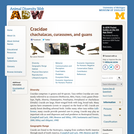
Cracidae: Information
- Subject:
- Life Science
- Zoology
- Material Type:
- Reading
- Provider:
- University of Michigan Museum of Zoology
- Provider Set:
- Animal Diversity Web
- Author:
- Laura Howard (author), Animal Diversity Web Staff
- Date Added:
- 03/07/2005
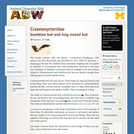
Craseonycteridae: Information
- Subject:
- Life Science
- Zoology
- Material Type:
- Reading
- Provider:
- University of Michigan Museum of Zoology
- Provider Set:
- Animal Diversity Web
- Date Added:
- 09/19/2001
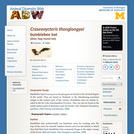
Craseonycteris thonglongyai: Information
- Subject:
- Life Science
- Zoology
- Material Type:
- Reading
- Provider:
- University of Michigan Museum of Zoology
- Provider Set:
- Animal Diversity Web
- Author:
- Anjali Goswami (author), University of Michigan
- Date Added:
- 06/07/1999
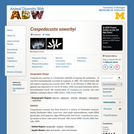
Craspedacusta sowerbyi: Information
- Subject:
- Life Science
- Zoology
- Material Type:
- Reading
- Provider:
- University of Michigan Museum of Zoology
- Provider Set:
- Animal Diversity Web
- Author:
- Autumn Erwin (author), Southwestern University
- Date Added:
- 10/04/2000
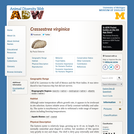
Crassostrea virginica: Information
- Subject:
- Life Science
- Zoology
- Material Type:
- Reading
- Provider:
- University of Michigan Museum of Zoology
- Provider Set:
- Animal Diversity Web
- Author:
- Paula Osborne (author), University of Michigan
- Date Added:
- 06/07/1999

Crateromys schadenbergi: Information
- Subject:
- Life Science
- Zoology
- Material Type:
- Reading
- Provider:
- University of Michigan Museum of Zoology
- Provider Set:
- Animal Diversity Web
- Author:
- Katie Wiedmeyer (author), University of Wisconsin-Stevens Point
- Date Added:
- 05/14/2004
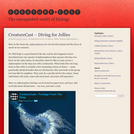
Here in the Dunn lab, siphonophores are our favorite animal and the focus of much of our research. Dr. Phil Pugh is a good friend of the lab, and he also happens to have described more new species of siphonophores than anyone who has ever lived. In the video below, he describes what it’s like to come across a siphonophore in the deep sea with a submarine. What looks like one long body in this video is actually a free-swimming colony of clones — many genetically identical bodies that are all attached. But each body in the group isn’t just like its neighbor. They each do a specific job for the colony. Some individuals will swim, some will catch food, and some will reproduce.
- Subject:
- Biology
- Life Science
- Zoology
- Material Type:
- Lecture
- Provider:
- Dunn Lab at Brown University
- Provider Set:
- CreatureCast
- Date Added:
- 09/25/2013

Robert Sandler tells the story of doliolid reproduction. The video was made with paper puppets and hand-drawn animations. Robert made this episode with support from the Society of Royce Fellows.
- Subject:
- Biology
- Life Science
- Zoology
- Material Type:
- Lecture
- Provider:
- Dunn Lab at Brown University
- Provider Set:
- CreatureCast
- Author:
- Robert Sandler
- Date Added:
- 09/08/2012

Riley Thompson, from the College of the Atlantic, tells the story of how animals become invisible.
- Subject:
- Biology
- Life Science
- Zoology
- Material Type:
- Lecture
- Provider:
- Dunn Lab at Brown University
- Provider Set:
- CreatureCast
- Author:
- Riley Thompson
- Date Added:
- 09/08/2012
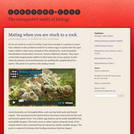
If you are stuck to a rock it is tricky to get close enough to a partner to mate. One solution to this problem would be to release eggs or sperm into the open water, which is what many animals in this situation do. Acorn barnacles (Semibalanus balanoides), however, found a different solution. They have evolved the longest penis relative to their body size of any animal. In this video the penises of several barnacles are probing the neighborhood for mates. The penis is re-grown each mating season.
- Subject:
- Biology
- Life Science
- Zoology
- Material Type:
- Lecture
- Reading
- Provider:
- Dunn Lab at Brown University
- Provider Set:
- CreatureCast
- Date Added:
- 11/06/2009

Robert Sandler tells the story of ocean slime, using stop motion and jellyfish puppets. Robert made this episode with support from the Society of Royce Fellows.
- Subject:
- Biology
- Life Science
- Zoology
- Material Type:
- Lecture
- Provider:
- Dunn Lab at Brown University
- Provider Set:
- CreatureCast
- Author:
- Robert Sandler
- Date Added:
- 09/08/2012

This video demonstrates some of the features of PhyloTree. It then shows the early explosive discovery of mammal species (most major mammal groups were discovered early on), and then shows the slow and steady discovery of cnidarians (many cnidarians remain to be described). The tool can also be used to quickly find the first species that was described in a group. The first siphonophore to be described, for example, was Physalia physalis (the Portuguese man o’ war).
- Subject:
- Biology
- Life Science
- Zoology
- Material Type:
- Lecture
- Provider:
- Dunn Lab at Brown University
- Provider Set:
- CreatureCast
- Author:
- Casey Dunn
- Date Added:
- 09/26/2013

Alysse Austin, a student in Casey Dunn’s Invertebrate Zoology course at Brown University, describes sexual dimorphism in green spoonworm.
- Subject:
- Biology
- Life Science
- Zoology
- Material Type:
- Lecture
- Provider:
- Dunn Lab at Brown University
- Provider Set:
- CreatureCast
- Date Added:
- 09/25/2013

Here is a semi-interactive video (with the option of a single, non-interactive video here) from CreatureCast alum Sophia Tintori, featuring tips from a handful of ocean-dwellers that each have drastically different approaches to being invisible.
- Subject:
- Biology
- Life Science
- Zoology
- Material Type:
- Lecture
- Provider:
- Dunn Lab at Brown University
- Provider Set:
- CreatureCast
- Author:
- Sophia Tintori
- Date Added:
- 04/15/2013

In this first video, Alison Sweeney talks about work that has been done in the Morse lab on Squid iridescence.
- Subject:
- Biology
- Life Science
- Zoology
- Material Type:
- Lecture
- Provider:
- Dunn Lab at Brown University
- Provider Set:
- CreatureCast
- Author:
- Alison Sweeney
- Date Added:
- 08/12/2009
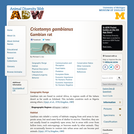
Cricetomys gambianus: Information
- Subject:
- Life Science
- Zoology
- Material Type:
- Reading
- Provider:
- University of Michigan Museum of Zoology
- Provider Set:
- Animal Diversity Web
- Author:
- Soo Young Joo (author), University of Michigan
- Date Added:
- 03/07/2005
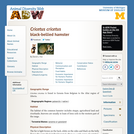
Cricetus cricetus: Information
- Subject:
- Life Science
- Zoology
- Material Type:
- Reading
- Provider:
- University of Michigan Museum of Zoology
- Provider Set:
- Animal Diversity Web
- Author:
- David L. Fox (author), University of Michigan
- Date Added:
- 06/07/1999
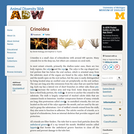
Crinoidea: Information
- Subject:
- Life Science
- Zoology
- Material Type:
- Reading
- Provider:
- University of Michigan Museum of Zoology
- Provider Set:
- Animal Diversity Web
- Author:
- Daphne G. Fautin (author)
- Derek Kellogg (author)
- Date Added:
- 07/27/2001

This activity will help students learn about Minnesota animals and characteristics that distinguish them from one another.
- Subject:
- Life Science
- Zoology
- Material Type:
- Activity/Lab
- Lesson Plan
- Provider:
- Science Education Resource Center (SERC) at Carleton College
- Provider Set:
- Pedagogy in Action
- Date Added:
- 01/20/2012
